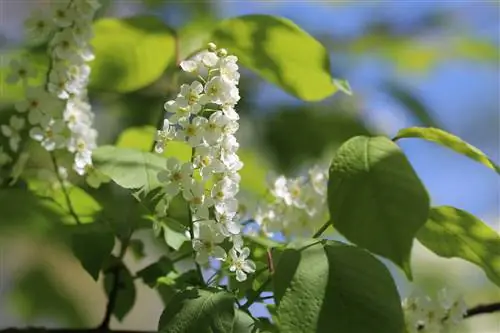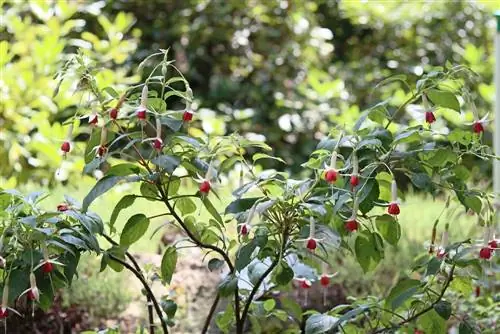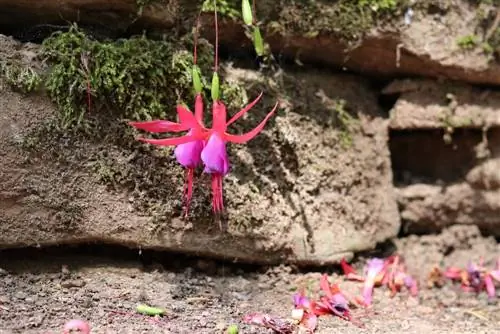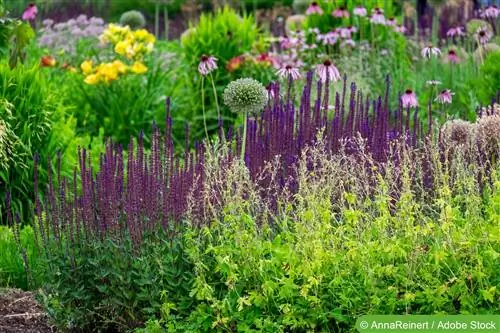- Author admin [email protected].
- Public 2023-12-17 03:39.
- Last modified 2025-06-01 06:48.
Whether in the garden or on the balcony: the colorful fuchsia flowers are always an eye-catcher. In addition to choosing the right location, professional care is also crucial.
Location
In terms of location, the fuchsia is adaptable because it can cope with both partially shaded and shady places. Many varieties can also cope with sun and even bloom more profusely than in the shade. However, with fuchsias in pots and balcony boxes, the blazing midday sun should be treated with caution, as the containers and thus also the root balls heat up quickly. For this reason, fuchsias in pots should preferably be placed where they can enjoy the mild morning sun or late afternoon sun. Ultimately, sun tolerance depends on the plant's environment, as it is influenced by the following factors, among others:
- Neighboring plants
- Humidity
- Water supply
- Nutrients
- Genetic characteristics of the variety
Soil / Substrate
Fuchsias are relatively undemanding when it comes to the soil or substrate. In order for the flower to develop as best as possible, the soil should still meet certain requirements. Peat-free and lightly pre-fertilized standard soil and pricking substrate are best suited for cultivation in a bucket. Once the flower is well rooted, it can be transplanted into high-quality, peat-free and nutrient-rich soil. Fuchsia feels most comfortable in a substrate with the following properties:
- Nutrient Rich
- Humos
- Fresh-moist
- Slightly acidic pH between 5.5 - 6.5
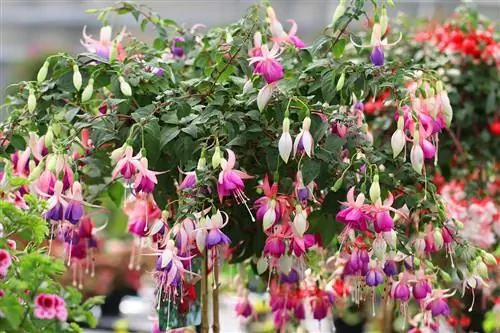
If you want to cultivate fuchsia in the garden, you should always make sure that the root area is kept cool and moist. For this reason, the root area should be shaded, such as with bark mulch. Alternatively, you can also underplant with evergreen ground cover, such as ivy or small evergreen. This not only protects the root area, but also acts as winter protection in the cold season.
Pots / Buckets
Fuchsias can easily be cultivated in a wide variety of containers, as they look very good in pots as well as in balcony boxes or hanging baskets. It is important that the vessels are made of a material that does not heat up so quickly. Accordingly, black plastic pots are only recommended if they are placed in a cooling clay pot or placed under sun protection. Otherwise, the root ball will heat up too quickly, which can damage the plant. When choosing the container, you should also make sure that it is not too large. If the pot is too large, the growth of the leaves will be promoted, but the buds will not develop as abundantly and the root ball will not be as stable. In addition, the following should be taken into account when growing in pots etc.:
- Water drainage on the floor prevents waterlogging
- Approx. 5 - 7 plants per 1 m balcony box
- Hanging baskets with a diameter of 20 cm or more, approx. 3 plants
Planting
Fuchsias can only be planted in the bed from mid-May at the earliest, provided that ground frost is no longer expected. In harsh winter locations, however, it is advisable to wait until early June before planting. As long as the temperatures no longer fall into the minus range, the fuchsia can be prepared for planting. To do this, the root ball is soaked by placing the plant in a container with water. In the meantime, the planting hole can be prepared as follows and the fuchsia can then be planted:
- Remove weeds, roots and stones from the soil at the location
- Rake the soil until a crumb structure is created
- approx. Dig a 10 cm deep depression
- Dig a hole in a hollow
- Hole should have twice the volume of the root ball
- Place fuchsia 8 - 10 cm deeper than it was previously in the pot
- Water thoroughly
Note:
The hollow is not filled immediately after planting, but rather proportionally to the growth over the course of summer to autumn!
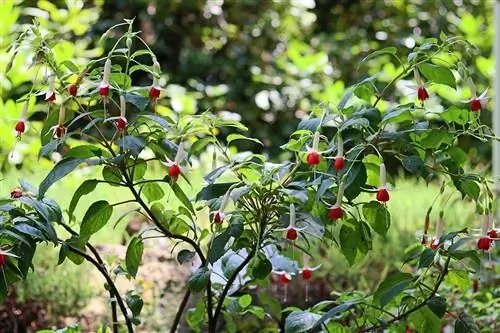
If you want to continue cultivating the fuchsia in a pot, you should also put it in fresh substrate after purchasing it. To protect the fuchsia from waterlogging, it is recommended to create a drainage system. For this purpose, a few pieces of pottery are placed over the water drain and an air and water permeable fleece is attached between the substrate and the drainage.
Fertilize
In order for the fuchsia to grow and thrive extensively, it should be regularly supplied with nutrients. A slightly high-potash liquid fertilizer that contains only a little phosphorus is best suited for this purpose. This is administered once a week from March to August, although the fertilizer dosage should not be too high. Many hobby gardeners swear by dividing the fertilizer application between two watering sessions. Additionally, the following should be taken into account when fertilizing:
- Never fertilize on dry soil or in high heat!
- Always water with clear water first
- Only then add fertilizer
Pouring
When it comes to watering fuchsias, some sensitivity is required because they don't like too much or too little water. In general it can be said that the plants should only be watered when necessary. This can be determined using a thumb test: If the root ball is still moist, there is no need to water. If the root ball has dried out since the last watering, the fuchsia should be watered. With regard to irrigation, the following care measures have also proven to be effective:
- Water in the morning or evening
- Best with tempered rainwater or decalcified tap water
- Never pour cold water on the warmed root ball
Note:
Low humidity causes the buds to wither and the foliage to fall off prematurely. It is therefore advisable to spray fuchsias regularly with water in high temperatures and dry weather.
Fuchsias tend to droop their leaves in extreme temperatures to protect themselves from evaporation. As soon as the heat subsides, the leaves straighten up again. However, the plants should not be watered until then because the roots cannot absorb the water. It is better to wait until the root ball is dry. Hobby gardeners can then place the plants in a shady place and water them as usual.
Cutting
A regular care measure is weekly cleaning of the fuchsia: this involves removing fallen leaves, ovaries and anything that has faded. The plant can also be checked for conspicuous leaves, diseases and pests at this time. Pruning is recommended in autumn by removing dried flowers and dead branches. However, only shoots that grew in the same year should be cut off. The fuchsia variety must also be taken into account when cutting, as different care measures are recommended depending on the variety:
- Compact bushes: Shorten last year's leading shoots by 1/3
- High trunks: cut back all unbranched shoots in the crown to 1 - 2 pairs of buds
- Hanging fuchsias: Trim overhanging shoots down to the last pair of leaves below the edge of the pot
Note:
If high trunks have not been cut for a while, the crown can be rejuvenated with a cut down to the old wood.
Wintering
Most fuchsias are not hardy, which is why they must either be moved to winter quarters or provided with winter protection. To prepare the plants for winter, all flowers and soft shoots should first be removed. The shoots are then cut off by around 2/3 of their length. A fuchsia cultivated in a pot can then move to its winter quarters, which should have the following properties:
- Temperatures 5 - 10 degrees Celsius
- Can also be dark
- A dark basement works well
- Do not fertilize and water only slightly
Note:
In a dark and cool winter quarter, the fuchsia loses its leaves. In a warmer location it retains its foliage, but then it also needs more light!
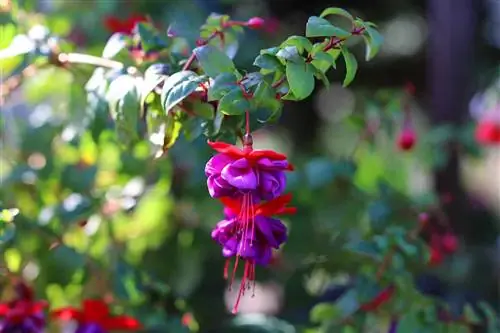
Fuchsias cultivated in the garden are not cut back before winter, but are directly covered with a breathable fleece. It is also advisable to protect the plant from frost with straw or leaves. As soon as the temperatures no longer fall below -5 degrees Celsius, the root disk can be cleared and the hood removed.
Propagation
Fuchsia can be sown or propagated from cuttings. The latter is the more common method and can be done both in spring and August. Propagation itself is easy and requires little work and time:
- 7 - cut 10 cm long shoot tips
- Cut off above a pair of leaves
- Remove bottom leaves
- Place cuttings in soil-sand mixture
- Place in the shade and keep moist
Propagation via cuttings can also be done in water by simply placing the cut shoot in a glass of water. As a rule, the first roots form after about two weeks.
Diseases and pests
The fuchsia is generally quite insensitive to diseases, but powdery mildew or gray mold occasionally occurs due to care errors. Pests can also cause problems for the fuchsia, such as aphids, whiteflies, red spiders or black weevils.


